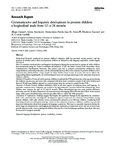Communicative and linguistic development in preterm children: a longitudinal study from 12 to 24 months.
| dc.contributor.author | Cattani, Allegra | |
| dc.contributor.author | Bonifacio, S | |
| dc.contributor.author | Fertz, M | |
| dc.contributor.author | Iverson, JM | |
| dc.contributor.author | Zocconi, E | |
| dc.contributor.author | Caselli, MC | |
| dc.date.accessioned | 2013-12-05T13:49:01Z | |
| dc.date.accessioned | 2013-12-05T13:49:36Z | |
| dc.date.available | 2013-12-05T13:49:01Z | |
| dc.date.available | 2013-12-05T13:49:36Z | |
| dc.date.issued | 2010-03 | |
| dc.identifier.issn | 1368-2822 | |
| dc.identifier.issn | 1460-6984 | |
| dc.identifier.uri | http://hdl.handle.net/10026.1/2845 | |
| dc.description.abstract |
BACKGROUND: Research conducted on preterm children's linguistic skills has provided varying pictures, and the question of whether and to what extent preterm children are delayed in early language acquisition remains largely unresolved. AIMS: To examine communicative and linguistic development during the second year in a group of Italian children born prematurely using the 'Primo Vocabolario del Bambino' (PVB), the Italian version of the MacArthur-Bates Communicative Development Inventory. The primary goal was to compare action/gesture production, word comprehension, and word production, and the relationship between these three domains in preterm children and to normative data obtained from a large sample of Italian children born at term. A second aim was to address the longstanding debate regarding the use of chronological versus corrected gestational age in the assessment of preterm children's abilities. METHODS & PROCEDURES: Parents of twelve preterm children completed the PVB questionnaire at five age points during the children's second year, and scores were compared with those from a normative sample of full-term children and those of 59 full-term children selected as a control group from the normative sample for the PVB. OUTCOMES & RESULTS: Preterm children exhibited a delay in all three aspects of communication and language. In particular, communicative-linguistic age tended to lag approximately 3 months behind chronological age when children were between the ages of 12 and 24 months. When chronological age was used, preterm children's percentile scores for all three components of communication and language fell within the lower limits of the normal range, while scores calculated using corrected age either fell at or above the 50th percentile. CONCLUSIONS & IMPLICATIONS: Findings suggest that despite the significant biological risk engendered by premature birth, early communicative and linguistic development appears to proceed in a relatively robust fashion among preterm children, with tight relations across communicative domains as in full-term children. Employing both chronological and corrected gestational age criteria in the evaluation of preterm children's abilities may provide important information about their progress in language acquisition. This may be especially important during the initial stages of communicative and linguistic development, inasmuch as comparisons of the two sets of scores may provide clinicians with a way to distinguish children who may be at risk for language problems from those who may be expected to progress normally. | |
| dc.format.extent | 162-173 | |
| dc.format.medium | ||
| dc.language | en | |
| dc.language.iso | en | |
| dc.publisher | Wiley | |
| dc.relation.replaces | http://hdl.handle.net/10026.1/2844 | |
| dc.relation.replaces | 10026.1/2844 | |
| dc.subject | Birth Weight | |
| dc.subject | Child Development | |
| dc.subject | Child Language | |
| dc.subject | Child, Preschool | |
| dc.subject | Communication | |
| dc.subject | Comprehension | |
| dc.subject | Female | |
| dc.subject | Gestures | |
| dc.subject | Humans | |
| dc.subject | Infant | |
| dc.subject | Infant, Newborn | |
| dc.subject | Infant, Premature | |
| dc.subject | Language Development | |
| dc.subject | Language Development Disorders | |
| dc.subject | Linguistics | |
| dc.subject | Longitudinal Studies | |
| dc.subject | Male | |
| dc.subject | Nonverbal Communication | |
| dc.subject | Parents | |
| dc.subject | Surveys and Questionnaires | |
| dc.title | Communicative and linguistic development in preterm children: a longitudinal study from 12 to 24 months. | |
| dc.type | journal-article | |
| dc.type | Journal Article | |
| plymouth.author-url | https://www.ncbi.nlm.nih.gov/pubmed/22748029 | |
| plymouth.issue | 2 | |
| plymouth.volume | 45 | |
| plymouth.publication-status | Published | |
| plymouth.journal | International Journal of Language and Communication Disorders | |
| dc.identifier.doi | 10.3109/13682820902818870 | |
| plymouth.organisational-group | /Plymouth | |
| plymouth.organisational-group | /Plymouth/Faculty of Health | |
| plymouth.organisational-group | /Plymouth/Users by role | |
| dc.publisher.place | United States | |
| dcterms.dateAccepted | 2009-02-11 | |
| dc.identifier.eissn | 1460-6984 | |
| dc.rights.embargoperiod | Not known | |
| rioxxterms.versionofrecord | 10.3109/13682820902818870 | |
| rioxxterms.licenseref.uri | http://www.rioxx.net/licenses/all-rights-reserved | |
| rioxxterms.licenseref.startdate | 2010-03 | |
| rioxxterms.type | Journal Article/Review |


